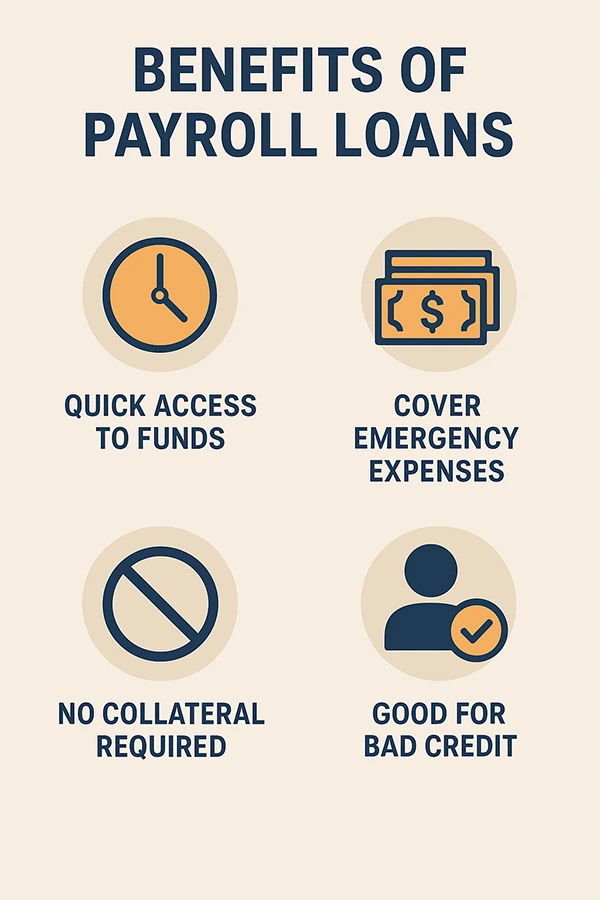Payroll loans are short term loans to cover employee wages. They are available to businesses with verifiable payroll records and consistent revenue.
KEY TAKEAWAYS
- Payroll loans provide short-term funds to cover employee wages during cash flow gaps.
- Payroll loans ensure staff get paid on time, maintaining trust and productivity.
- High interest rates and short repayment terms make careful planning essential.
- Alternatives include credit lines, invoice factoring, or government emergency funding.

A report has mentioned that nearly 22% of small businesses in America have experienced cash flow issues at some point in time and struggled to rationalize paying their employees.
A short-term payroll funding option is exactly what you need. Short-term payroll funding is a specific type of short-term financing to make payroll on time, guaranteed to be paid off by the next payroll date. To put it another way, it allows you to consistently pay employees, even when the timing of your revenue may not be consistent.
In this article, we will walk through how these loans work, what the potential benefits are, which risks exist, and under what conditions companies should consider them.
What are Payroll Loans?
Payroll loans are short-term financing solutions created specifically to cover employee wages during temporary cash flow gaps. They differ from regular business loans, typically used for growth, buying equipment, or supporting larger and long-term initiatives. Payroll loans exist solely to ensure staff get paid on time.
In simple terms, they act as a financial lifeline for businesses facing urgent payroll needs. These loans sit within the broader world of small business payroll funding and short-term financing. They are not meant to replace careful financial planning. Rather, they serve as a bridge for short gaps, sustaining operations and supporting employees.
Firms such as Riseworks.io see payroll loans as one part of a wider approach to business stability. At Rise, we consider payroll loans as part of a wider liquidity plan. To me, they act more like a bridge than a crutch. Most SMEs deal with cash flow swings from late payments, seasonal demand, or unexpected costs.
That’s when payroll loans provide relief, ensuring employees are paid promptly while business operations keep moving without disruption. But, I must say, the real goal is pairing this short-term support with better cash management practices to stop bigger problems before they even start,” said Austin Heaton, Head of Content at Riseworks.io.
According to Heaton, payroll loans are not just a reactive measure. They allow business owners to manage volatility, plan ahead and keep operations running. Below, you can see the major benefits of payroll loans.

How Payroll Loans Work?
Payroll loans provide fast, short-term funds to cover employee wages when cash flow runs dry. The speed is essential because payroll deadlines can’t be delayed. Lenders quickly process applications and typically disburse funds within 24 to 72 hours.
Companies must submit payroll verification, key financial records, and proof of revenue or accounts receivable. Some lenders do minimal credit checks, so loans are available to businesses with imperfect credit histories.

Once approved, funds are used to pay staff and repaid according to agreed terms, usually within a few weeks or months. Loan amounts are smaller than traditional business loans.
It’s worth comparing payroll loans to other short-term financing options. Bridging loans, for example, are used in property deals to cover temporary gaps, with costs measured by bridging loan interest rates. According to KIS Finance, though bridging loans and payroll loans serve distinct purposes, both highlight the critical need for fast access to funds. Comparing multiple offers is key to finding terms that work for your business.
When Businesses Use Payroll Loans?
Payroll loans are taken whenever cash flow endangers meeting employee wage payments promptly. Some common scenarios are seasonal slowdowns, late customer payments, delayed invoices, unexpected expenses that reduce working capital or rapid growth where payroll obligations exceed incoming funds.
In these cases, payroll loans give owners a break. They ensure staff get paid on time, maintain trust and productivity, and keep operations running without disruption.

Pros and Cons of Payroll Loans
The essential pros and cons of payroll loans have been listed below:
Alternatives to Payroll Loans
Payroll loans are not the only solution for covering payroll needs. Business lines of credit give access to funds that can be used multiple times for different expenses. Invoice factoring lets companies turn unpaid invoices into immediate cash. Emergency programs or government grants can also provide short-term support.
Personal loans from credit unions can provide competitive rates with flexible repayment as well.
Payroll loans combined with other alternatives can help business owners identify the most sensible and affordable approach.
Conclusion
For SMEs payroll is non-negotiable. Payroll loans are a fast and focused way to cover short-term gaps, protect employee satisfaction, and keep operations smooth. They don’t replace financial planning, but they help avoid disruptions when business cash flow temporarily runs dry.







